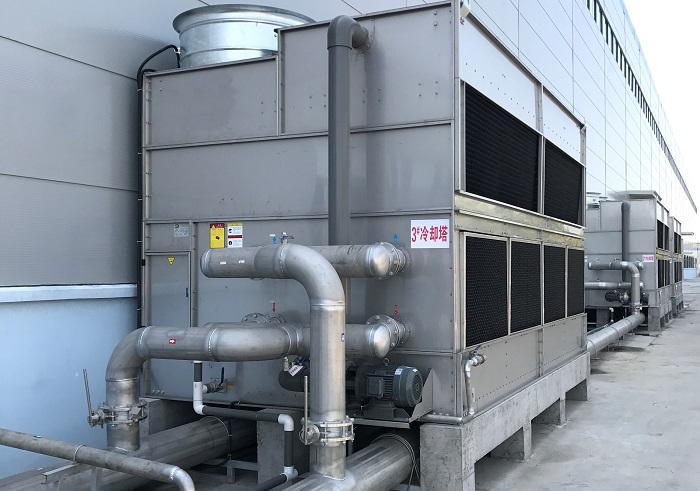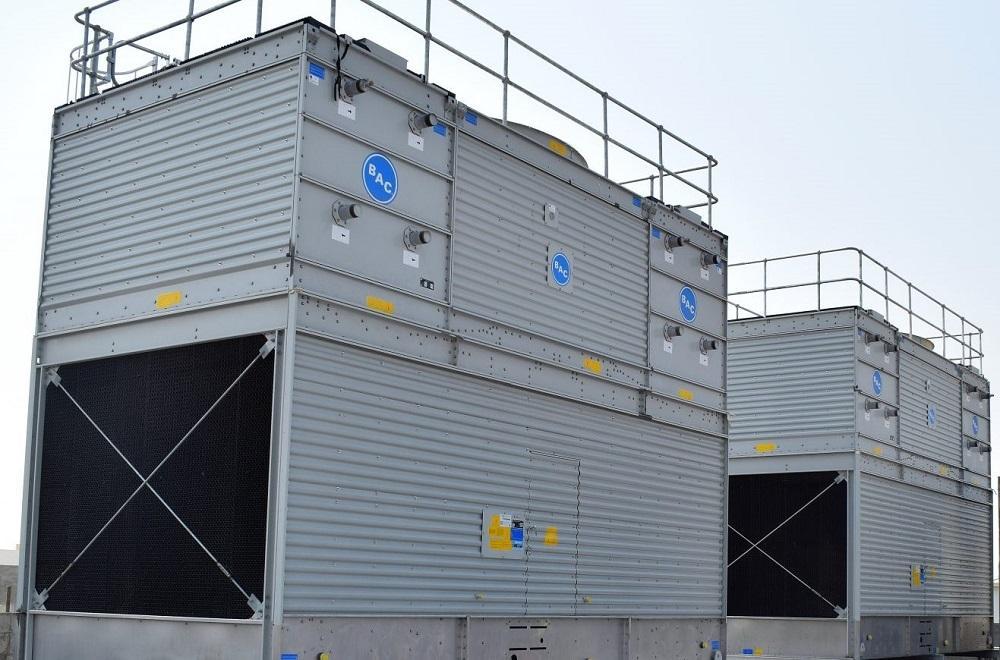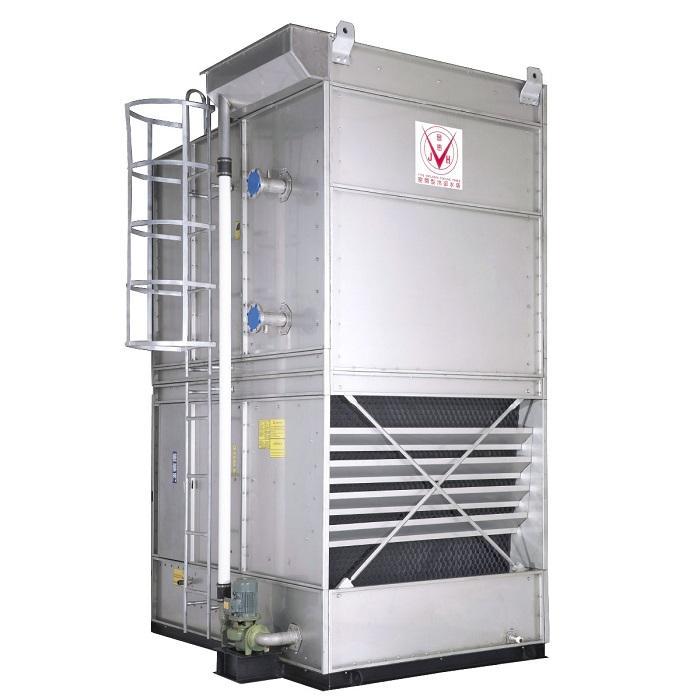With the ability to reduce heat in a system by different means and reject heat waste to the open air, cooling towers play a great role in many industrial processes. They help to avoid overheating of the system that can turn into a disaster. With this in mind, raising your knowledge of these giant devices is a must; especially when you have to deal with them at work. In this article, Linquip has provided useful information about closed circuit cooling towers. So read on and expand your knowledge.
What are closed circuit cooling towers?
With respect to the heat transfer mechanism employed, closed circuit cooling tower or simply the fluid cooler is one of the main types of cooling towers which dissipate the process fluid heat load into the ambient air via a heat exchange coil. This isolates the process fluid from the outside air, keeping it clean and free of contamination in a closed loop and creating two separate fluid circuits:
- An external circuit, in which spray water circulates over the coil and mixes with the outside air.
- An internal circuit, in which the process fluid circulates inside the coil.
Closed circuit cooling towers principle of operation
There is no direct contact between the water to cool down and the air inside closed circuit cooling towers, but an additional heat exchanger is nevertheless used. Cooling towers with piping and plate heat exchanger also exist. Closed circuit towers operate similarly to open towers except there is a heat exchanger coil within the tower that separates the cooling tower water from the building cooling water.
During operation cooling tower water is pumped from the basin up to a spray header where it is then sprayed onto a coil containing the building cooling water thereby cooling it down. Since building cooling water is contained in the coil, it is not exposed to the atmosphere and not subject to fouling caused by oxygen and dirt.
Different Types of Closed Circuit Cooling Towers
There are four primary types of closed loop cooling towers.
- Evaporative closed-circuit coolers: this type of closed-circuit coolers eliminates the need for a heat exchanger between the process loop and the heat rejection equipment. Unlike a cooling tower, where process water is used as the energy transfer medium and is open to the atmosphere, the coil inside a closed-circuit cooler isolates the process fluid.
These coolers provide energy-efficient operation in a reduced footprint compared to dry coolers, due to evaporation being used as the primary method of cooling. Because blow down of the basin water is reduced on closed-loop systems, water conservation is also improved when compared to open-loop systems.
- Eco/Hybrid Closed Circuit coolers: Hybrid coolers combine dry and evaporative cooling to maximize energy efficiency while simultaneously reducing water consumption. These units provide heat rejection in dry mode until the load exceeds dry rejection capacity. At this switch-over point, the unit enters evaporative mode to increase cooling capacity. Operating in wet mode only when needed can dramatically reduce annual water consumption, sewer expense, and eliminate plume while in dry mode.
- Adiabatic coolers: coolers function similarly to dry cooling systems, but with the addition of pre-cooling pads. Water runs over porous media while air is drawn through the pads, lowering the dry bulb temperature of the incoming air. The influence of reduced dry bulb temperatures at the coil provides greater heat rejection. As a result, adiabatic systems are most effective in hot, dry environments, and use up to 80% less water than traditional evaporative units. Adiabatic units also deliver the required cooling capacity in a smaller footprint and/or lower fan motor horsepower than a completely dry cooler.
- Dry coolers: Dry coolers are best specified where water conservation and reduced maintenance are the key considerations. Since dry coolers do not utilize any water or evaporative cooling whatsoever, dry coolers eliminate water treatment, all plume and Legionella concerns. However, dry coolers will use more energy and require a larger footprint than evaporative or hybrid fluid coolers of the same capacity.
In a dry cooler, heat from the process loop fluid dissipates through the coil tube surface and out to the fins – not through evaporation. Ambient air is drawn in over the coil surface by a fan located at the top of the unit. Heat from the process fluid is transferred to the air via sensible cooling and discharges to the atmosphere.

Closed Circuit Cooling Towers Advantages
- Contaminant-free cooling circuit
- Dry operation in winter
- Reduced system maintenance that results in less downtime, which is particularly important for data centers and critical process cooling applications.
- Lower overall system costs thanks to year-round savings on maintenance, water, energy and water treatment
- Water loss through evaporation is either reduced or eliminated, depending on the type of closed loop cooling equipment selected
- They reduce or even eliminate the need for chemical treatment of system fluids
- They Protect the quality of the process fluid
- They Provide operational flexibility at a slightly higher first cost
- They can also provide completely dry sensible heat rejection which can greatly reduce the overall water consumption on a project.
- The can be sized for full design or partial load based on a dry bulb switchover temperature.
Differences between the open and closed circuit cooling towers
While open-loop cooling towers reject heat in a smaller footprint than closed loop fluid coolers (due to the process fluid being cooled via direct latent heat transfer), closed-loop systems benefit from sustained thermal performance of the entire system. Higher whole-system efficiency over time is achieved because heat transfer surfaces experience less fouling. Closed-loop systems also typically require less pumping horsepower than open loop systems of similar capacity.
Furthermore, with a closed-loop system, there are significant installation savings attributed to the reduced pumping HP required, the elimination of an intermediate plate-and-frame heat exchanger, and the elimination of expensive valves and additional pipework. This is coupled with the lifetime operational savings including reduced water treatment/chemicals, reduced water consumption, and reduced maintenance. Comparing just an open cooling tower to a closed circuit cooler in terms of price does not tell the whole story, when considering the up-front additional installation costs and operational costs of an open-loop system.
In addition, compared to open-loop cooling towers, closed circuit cooling towers provide more flexibility in terms of where heat rejection equipment is installed. Closed-loop systems also do not require hydraulic balancing or equalization. Because of this, fluid coolers can be installed at or below the level of the connected system piping. Conversely, installing a cooling tower below grade or below the pump could result in the tower flooding when the unit shuts down.
Last but not least, closed-loop equipment also provide an advantage for cooling systems operating in sub-freezing outdoor temperatures. Some types of closed loop equipment may still require freeze protection of some sort, but all open loop cooling towers must be equipped with basin heaters, a drain-back design or a recirculation system for idle periods in freezing conditions.
So, this is all you need to learn about closed circuit cooling towers and their advantages over open circuit tower. Care to share your opinion on different cooling towers in Linquip? Use the comment section to do so. If you have any question regarding the topic, feel free to sign up on our website and get the most out of our experts.
Buy Equipment or Ask for a Service
By using Linquip RFQ Service, you can expect to receive quotations from various suppliers across multiple industries and regions.
Click Here to Request a Quotation From Suppliers and Service Providers
Read More In Linquip




